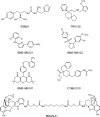Targeting multiple opioid receptors - improved analgesics with reduced side effects?
- PMID: 28378462
- PMCID: PMC6016677
- DOI: 10.1111/bph.13809
Targeting multiple opioid receptors - improved analgesics with reduced side effects?
Abstract
Classical opioid analgesics, including morphine, mediate all of their desired and undesired effects by specific activation of the μ-opioid receptor (μ receptor). The use of morphine for treating chronic pain, however, is limited by the development of constipation, respiratory depression, tolerance and dependence. Analgesic effects can also be mediated through other members of the opioid receptor family such as the κ-opioid receptor (κ receptor), δ-opioid receptor (δ receptor) and the nociceptin/orphanin FQ peptide receptor (NOP receptor). Currently, a new generation of opioid analgesics is being developed that can simultaneously bind with high affinity to multiple opioid receptors. With this new action profile, it is hoped that additional analgesic effects and fewer side effects can be achieved. Recent research is mainly focused on the development of bifunctional μ/NOP receptor agonists, which has already led to novel lead structures such as the spiroindole-based cebranopadol and a compound class with a piperidin-4-yl-1,3-dihydroindol-2-one backbone (SR16835/AT-202 and SR14150/AT-200). In addition, the ornivol BU08028 is an analogue of the clinically well-established buprenorphine. Moreover, the morphinan-based nalfurafine exerts its effect with a dominant κ receptor-component and is therefore utilized in the treatment of pruritus. The very potent dihydroetorphine is a true multi-receptor opioid ligand in that it binds to μ, κ and δ receptors. The main focus of this review is to assess the paradigm of opioid ligands targeting multiple receptors with a single chemical entity. We reflect on this rationale by discussing the biological actions of particular multi-opioid receptor ligands, but not on their medicinal chemistry and design.
Linked articles: This article is part of a themed section on Emerging Areas of Opioid Pharmacology. To view the other articles in this section visit http://onlinelibrary.wiley.com/doi/10.1111/bph.v175.14/issuetoc.
© 2017 The British Pharmacological Society.
Figures
Similar articles
-
Nociceptin/Orphanin FQ Peptide Receptor-Related Ligands as Novel Analgesics.Curr Top Med Chem. 2020;20(31):2878-2888. doi: 10.2174/1568026620666200508082615. Curr Top Med Chem. 2020. PMID: 32384033 Free PMC article. Review.
-
The first universal opioid ligand, (2S)-2-[(5R,6R,7R,14S)-N-cyclopropylmethyl-4,5-epoxy-6,14-ethano-3-hydroxy-6-methoxymorphinan-7-yl]-3,3-dimethylpentan-2-ol (BU08028): characterization of the in vitro profile and in vivo behavioral effects in mouse models of acute pain and cocaine-induced reward.J Pharmacol Exp Ther. 2011 Mar;336(3):952-61. doi: 10.1124/jpet.110.175620. Epub 2010 Dec 21. J Pharmacol Exp Ther. 2011. PMID: 21177476 Free PMC article.
-
Comparison of the antinociceptive and antirewarding profiles of novel bifunctional nociceptin receptor/mu-opioid receptor ligands: implications for therapeutic applications.J Pharmacol Exp Ther. 2009 Dec;331(3):954-64. doi: 10.1124/jpet.109.157446. Epub 2009 Sep 22. J Pharmacol Exp Ther. 2009. PMID: 19773529 Free PMC article.
-
A novel orvinol analog, BU08028, as a safe opioid analgesic without abuse liability in primates.Proc Natl Acad Sci U S A. 2016 Sep 13;113(37):E5511-8. doi: 10.1073/pnas.1605295113. Epub 2016 Aug 29. Proc Natl Acad Sci U S A. 2016. PMID: 27573832 Free PMC article.
-
Therapeutic potentials of NOP and MOP receptor coactivation for the treatment of pain and opioid abuse.J Neurosci Res. 2022 Jan;100(1):191-202. doi: 10.1002/jnr.24624. Epub 2020 Apr 7. J Neurosci Res. 2022. PMID: 32255240 Free PMC article. Review.
Cited by
-
ERK and p38 contribute to the regulation of nociceptin and the nociceptin receptor in human peripheral blood leukocytes.Mol Pain. 2019 Jan-Dec;15:1744806919828921. doi: 10.1177/1744806919828921. Mol Pain. 2019. PMID: 30665329 Free PMC article.
-
A bifunctional nociceptin and mu opioid receptor agonist is analgesic without opioid side effects in nonhuman primates.Sci Transl Med. 2018 Aug 29;10(456):eaar3483. doi: 10.1126/scitranslmed.aar3483. Sci Transl Med. 2018. PMID: 30158150 Free PMC article.
-
Synthesis and Structure-Activity Relationships of 5'-Aryl-14-alkoxypyridomorphinans: Identification of a μ Opioid Receptor Agonist/δ Opioid Receptor Antagonist Ligand with Systemic Antinociceptive Activity and Diminished Opioid Side Effects.J Med Chem. 2020 Jul 23;63(14):7663-7694. doi: 10.1021/acs.jmedchem.0c00503. Epub 2020 Jun 30. J Med Chem. 2020. PMID: 32530286 Free PMC article.
-
Crizotinib inhibits the metabolism of tramadol by non-competitive suppressing the activities of CYP2D1 and CYP3A2.PeerJ. 2024 May 30;12:e17446. doi: 10.7717/peerj.17446. eCollection 2024. PeerJ. 2024. PMID: 38827306 Free PMC article.
-
Differential In Vitro Pharmacological Profiles of Structurally Diverse Nociceptin Receptor Agonists in Activating G Protein and Beta-Arrestin Signaling at the Human Nociceptin Opioid Receptor.Mol Pharmacol. 2021 Jul;100(1):7-18. doi: 10.1124/molpharm.120.000076. Epub 2021 May 6. Mol Pharmacol. 2021. PMID: 33958480 Free PMC article.
References
-
- Abdelhamid EE, Sultana M, Portoghese PS, Takemori AE (1991). Selective blockage of delta opioid receptors prevents the development of morphine tolerance and dependence in mice. J Pharmacol Exp Ther 258: 299–303. - PubMed
-
- Ackley MA, Hurley RW, Virnich DE, Hammond DL (2001). A cellular mechanism for the antinociceptive effect of a kappa opioid receptor agonist. Pain 91: 377–388. - PubMed
-
- Bailey CP, Connor M (2005). Opioids: cellular mechanisms of tolerance and physical dependence. Curr Opin Pharmacol 5: 60–68. - PubMed
Publication types
MeSH terms
Substances
LinkOut - more resources
Full Text Sources
Other Literature Sources
Research Materials



